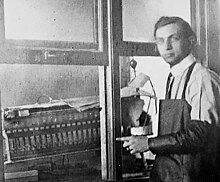Otto Julius Zobel | |
|---|---|
 Zobel in his laboratory | |
| Born | October 20, 1887 Ripon, Wisconsin, U.S. |
| Died | January 1970 (aged 82) Morristown, New Jersey, U.S. |
| Alma mater | University of Wisconsin |
| Known for | Electronic filter topology Zobel network Lattice phase equaliser m-derived filter double-m-derived filters General mn-type image filter Composite image filter Artificial transmission line Equivalent impedance transforms |
| Scientific career | |
| Fields | Electrical engineering |
| Institutions | AT&T Co, Bell Labs |
| Signature | |
 | |
| Notes | |
Zobel's signature in his draughtsmanlike hand as it appears on a patent application | |
Otto Julius Zobel (October 20, 1887 – January 1970) was an electrical engineer who worked for the American Telephone & Telegraph Company (AT&T) in the early part of the 20th century. Zobel's work on filter design was revolutionary and led, in conjunction with the work of John R. Carson, to significant commercial advances for AT&T in the field of frequency-division multiplex (FDM) telephone transmissions.[1]
Although much of Zobel's work has been superseded by more modern filter designs, it remains the basis of filter theory and his papers are still referenced today. Zobel invented the m-derived filter[2] and the constant-resistance filter,[3] which remain in use.
Zobel and Carson helped to establish the nature of noise in electric circuits, concluding that—contrary to mainstream belief[4]—it is not even theoretically possible to filter out noise entirely and that noise will always be a limiting factor in what is possible to transmit.[5] Thus, they anticipated the later work of Claude Shannon, who showed how the theoretical information rate of a channel is related to the noise of the channel.
- ^ Bray, p. 62.
- ^ White, Gerry (2000). "The Past". BT Technology Journal. 18 (1): 107–132. doi:10.1023/A:1026506828275.
- ^ Zobel, O J, Distortion Compensator, U.S. patent 1,701,552, filed June 26, 1924, issued February 12, 1929.
- ^ Schwartz, p. 9.
- ^ Cite error: The named reference
TransientOscillationwas invoked but never defined (see the help page).